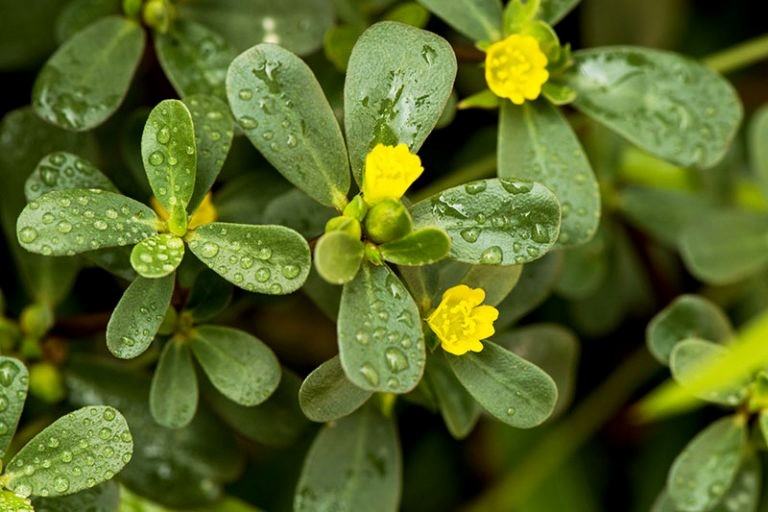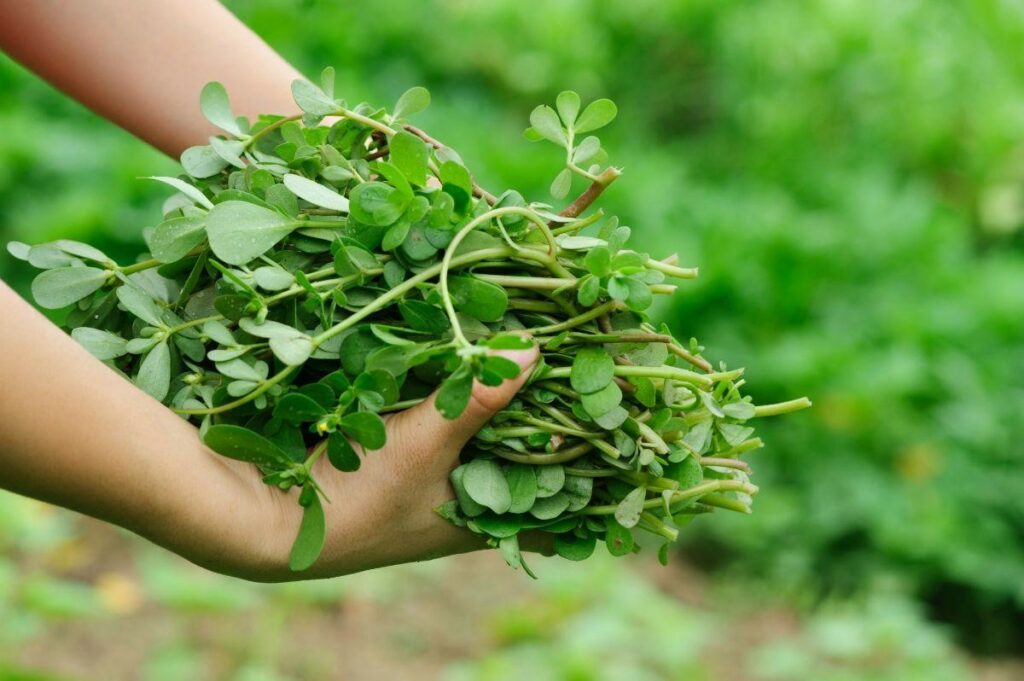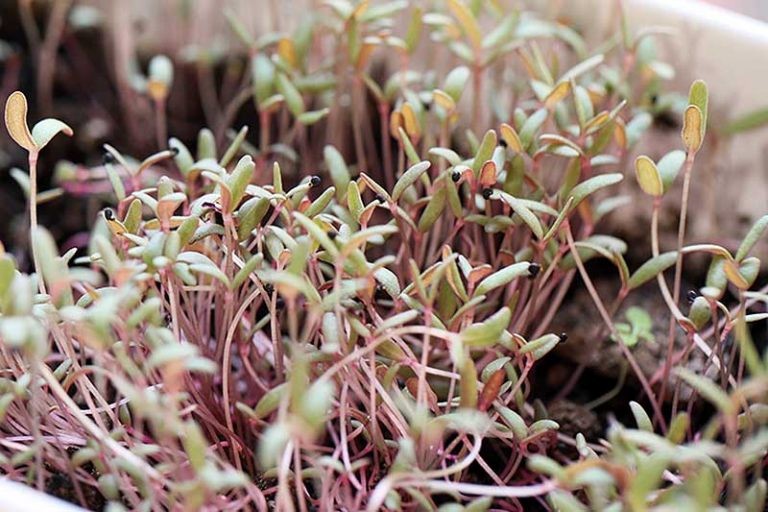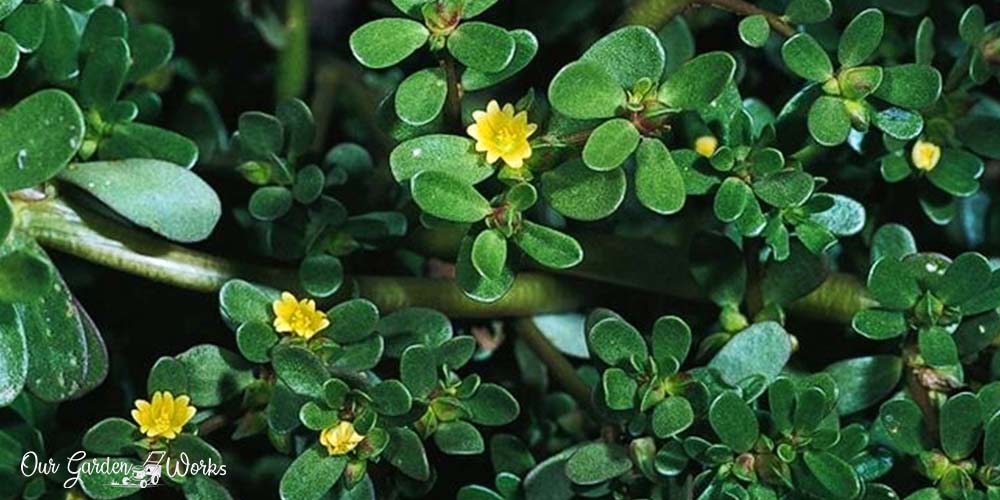It’s the warm season again, and it’s a perfect time for your plants to grow in your yard, including weeds. Your plants may treat weeds as competition but not all of them are entirely undesirable like the edible purslane.
To some who are not aware of their potential, purslanes might just be another unpleasant weed in the yard.
But these greens are one of the most nutritious wild edible plants to grow. Like many other edible weeds, purslane is not only delicious but also far more nutritious than many of the crops.
Purslane is low maintenance and can grow freely anywhere in your yard. However, cultivating them for a specific purpose has its ways.
In this post, we will share how to grow purslane and so you can add it as another good source of greens for your meals.
What is Purslane?

Portulaca oleracea or purslane, often treated as a weed, is a type of herb abundant in most vegetable gardens and flower beds.
There are other common names for purslane such as duckweed, little hogweed, and pursley. It also has more local names in various languages depending on which country you are in. It originated in Asia but is now common almost everywhere around the world.
Purslane is a succulent plant that may grow up to 16 inches in height. It has smooth and reddish stems and fleshy green leaves.
Its flowers are yellow that bloom at any time of the year. It tastes like spinach with a bit of salty and sour flavor. Preparation and serving of purslanes in the kitchen are the same way as lettuce and can also be an ingredient in vegetable salad and sandwiches.
Vitamins And Nutrients Found in Purslane
Purslane is a superfood. Aside from being tasty, it is also loaded with nutrients such as:
- Vitamin A: A natural antioxidant that helps improve your vision, healthy mucus membranes and protect you from lung and oral cancer. Purslane is known to be a green leafy vegetable with the highest content of Vitamin A.
- Vitamin C: Also known as ascorbic acid, Vitamin C is necessary for the growth, development, and repair of all body tissues
- Magnesium: An essential mineral, playing a role in over 300 enzyme reactions in the human body. Its many functions include improving muscle and nerve function, regulating blood pressure, and supporting the immune system.
- Manganese: Helps activate many enzymes in metabolism and play a role in various chemical processes in your body. It helps with protein and amino acid digestion and utilization and the metabolism of cholesterol and carbohydrates.
- Potassium: Helps regulate fluid balance, muscle contractions, and nerve signals in our brain.
- Iron: Aids in our growth and development and preserve many vital functions in the body, including general energy and focus, gastrointestinal processes, the immune system, and the regulation of body temperature.
- Calcium: Helps in maintaining strong bones and teeth.
Purslane also contains small amounts of the following vitamins:
- Vitamin B1: Helps the cells in the body convert food into energy
- Vitamin B2: Required by the body for cellular respiration.
- Vitamin B3: Helps lower cholesterol, ease arthritis and boost brain function
- Folate: Helps the body make healthy red blood cells and aids in a healthy pregnancy
- Copper: Together with iron, it enables the body to form red blood cells, maintain healthy bones, blood vessels, nerves, and immune function, and contributes to better iron absorption.
- Phosphorus: Along with calcium, phosphorus is needed to build strong healthy bones, as well as, keeping other parts of your body healthy.
Health Benefits of Purslane
Being a superfood, purslane is also dubbed as a miracle food. Regular consumption of purslane may lower the risk of cancer due to its beta-carotene content. It has seven times more beta-carotene than carrots and six times vitamin E content than spinach.
Purslane is also rich in omega-3 fatty acids. Consumption of foods rich in these acids may reduce the risk of coronary heart disease, stroke. It also helps prevent the development of ADHD, autism, and other developmental differences in children.
Purslane is also a natural remedy for insomnia. It has many of the same health benefits as other leafy greens and has fewer calories despite being packed with all these nutrients.
Steps on How To Grow Purslane

Purslane is drought resistant so it can thrive in dry soils. You can use any type of soil from sandy to loamy.
The best soil PH for this weed is around 6.0 to 7.0. Its ideal location is in the sunny area of your property.
There are two ways of growing purslane. The first is by planting seeds, and the other is through stem cutting or transplants. Either of the two is an effective method as long as you follow these simple steps:
Seed Method
(1) Select the right seed. There are over 40 varieties of purslane seeds. Choose the best that will fit your needs or taste.
Some varieties have larger leaves and more upright stems as they grow. But if you want to grow any kind, you can simply harvest seeds from wild purslanes available in your yard. During its lifetime, a single plant can produce at least 50,000 seeds until it grows old.
(2) Once the temperature is at least 60 degrees Fahrenheit or higher, sprinkle the seeds into the soil and lightly press them into it.
To guarantee successful germination, make sure that they are not covered. They need sunlight for this process. Wait for at least 7 to 10 days for them to completely sprout.
(3) Once new leaves start to emerge, trim them with at least 8 inches to encourage growth. You may transplant them once they are fully grown.
Stem Cutting Method
- Use of pruning shears. Remove the leaves from the middle to the bottom part of the stem.
- Plant the cut stem by burying at least half of it in the potting soil.
- Place the plant in a bright area but not directly exposed to sunlight. Make sure to keep the soil moist but not drenched.
- After a week, check if the cutting has already adapted to its new environment and started to grow. You can do this by giving it a light tug. It should firmly hold onto the soil. By this time, it is ready to be transplanted.
- Transplanting is an important step not only for purslane but also for most plants. This is the process of transferring the matured plants into their permanent location. These matured plants are the ones that are fully germinated.
In transplanting purslane, you simply have to dig the plant from the soil and make sure that the roots and stems are still attached and intact. Once done, dig a new hole into the new pot. The hole must be a little deeper than the original one to give some space for the roots and stem to grow. Place the uprooted plant into the new hole and fill it with dirt.
Helpful Tips in Growing Purslane At Home
- If you want to plant another batch of purslane, you can leave some roots and stems in the soil during transplanting. These parts will soon sprout to another plant again.
- Keep in mind that this plant is too easy to grow. Make sure that you harvest it regularly to avoid having undesirable weeds in your garden. Harvest the greens before the flowers bloom to slow down the spread of the weed seeds.
- If you want a mild flavor, harvest the greens during the evening. If you want it tarty, harvest during the morning.
- Make sure to grow purslanes in warm spots. These plants love the sun and cannot endure the cool weather.
- You can grow purslane as microgreens. Microgreens are technically the younger form of plants. They are harvested just after the cotyledon leaves have developed. This stage of plants comes after the sprouting stage. Here are the steps in growing microgreen purslanes:
Growing Purslane as a Microgreen

- In a seedling tray with holes, place at least a 1/2-inch layer of organic potting mix.
- Sprinkle seeds evenly, and cover them with a thin layer of soil mix.
- Place them in a sunny area with about 75 degrees Fahrenheit. Maintain the moisture in the soil until it is fully germinated.
- Once germinated, you can adjust the temperature between 60 degrees Fahrenheit to 70 degrees Fahrenheit.
- Keep the soil moist by watering the new sprouts. Avoid splashing water into the plants. Once the microgreens reach 2 to 4 inches, they will be ready for harvest.
- Once germination is done, make sure to keep the soil dry. Purslanes are fast-growing plants and they grow well on dry soil.
- If you want larger and juicier plants, grow purslanes in loamy, porous soil.
- Do not water your purslanes too much. Just provide it with consistent moisture and it will bloom into a leafier harvest. Purslanes tend to die if they get too much water.
- Harvest the purslane by collecting the stem, but avoid cutting it too short to enable regrowth.
- It is better to harvest young purslane stems since the leaves are more delicious. The younger the purslane leaves, the more they melt in your mouth.
- After harvest, keep the purslane in the freezer for a maximum of 3 days. Purslane doesn’t stay fresh for a long time, since it doesn’t hold well to freezing.
- Purslanes are slightly cooked like spinach since they can be eaten raw in mixed salads, or added in soups.
Frequently Asked Questions (FAQs)
Are purslanes edible?
Yes. Purslanes are edible and can be used as an ingredient for salads and sandwiches. They are one of the most underrated superfoods since they are dense with vitamins and minerals.
Are all varieties of purslane edible?
Almost all varieties of purslane are edible except moss rose. Lookalikes of purslanes such as Spurges (Euphorbia spp.) are poisonous and should not be consumed. The stems of spurges are hairy and produce white sap when the stem gets broken or scratched.
Is purslane easy to grow?
Yes. Purslanes can grow with low to no maintenance as it is considered a weed that grows a lot during the warm season.
What type of soil to use in growing purslanes?
Purslanes are not choosy about the type of soil, but purslane grows better in drier soil.
Where does purslane grow best?
All purslane needs to grow in part to full sun and dry soil. They often don’t need fertilization and can be persistent in providing green.
Does purslane grow every year?
Purslane is an annual succulent plant. The months to sow them are from March to September. You can start harvesting your purslane greens in late spring or late summer.
How long can I keep pursuing after harvest?
Since purslanes are a delicate type of plant, cooling it after harvest is needed. If the temperature is warm, they become gooey and sticky. It’s best to consume them after 3 days.
Why does it have to be grown in warm temperatures?
It is hard for purslane to grow in cooler temperatures. It may tolerate mild frost. However, since this plant is a tropical type, it can only grow during the warm season and die down once it is already cold.
How will I know if the weeds in my garden are purslanes?
Purslane’s distinguishing characteristics are the following:
- Stem: it is almost prostate, reddish, fleshy.
- Leaves: watery sap; succulent, which are broad-rounded at the tips.
- Flowers: small yellow-petaled flowers, and spherical many-seeded capsules, which open around the middle.
Do purslanes attract pests?
Purslane is known to be a hardy plant, and in the same family as other succulents. It is also prone to fungal disease during the wet season, or if the soil where it was planted is soggy or has poor soil drainage. However, there is no proof that it attracts pests.
How long does it take for purslane to grow?
The seedlings of purslane take at least 7 to 10 days to sprout after planting. Afterwhich, you can start harvesting their leaves to keep them producing more leaves.
Can I grow purslanes during the winter?
No, purslane can’t stand cold temperatures and will start to wilt in the first frost. It needs warmth and the brightness of the sun to grow properly.
Final Thoughts
Most of us overlook some nutrient-dense weeds like purslane due to the lack of knowledge about them.
Now that you already have enough knowledge on how to identify purslanes and their health benefits, we hope you will not just throw them away the next time you clean your garden.
Instead, make the most out of these tiny nutritional greens and enjoy an unlimited source of greens for your meals. It is much better if you start cultivating them and them in your vegetable garden in a separate plant bed.
We hope that this post helped you learn how to grow purslanes. If you find this post useful, please share it with your friends and colleagues.
Also, share your experience with your first batch of purslane harvest in the comment section below!
